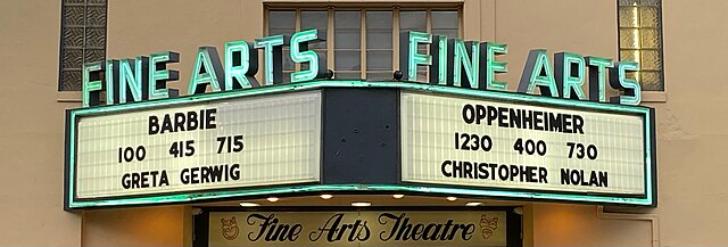.png)
Dr Samar Abdel Rahman and I discuss opinions and thoughts surrounding Barbie and Oppenheimer, as we await the biggest award event of the year - The 96th Academy Awards!
Barbie and Oppenheimer triumphed at the box office last July and are back in the spotlight for the upcoming award season. I imagined this would be similar to 2008's The Dark Knight and Mamma Mia double-bill, two films with stark contrasts.
Now, let's talk about Barbie.
Barbie's marketing immediately focused on a fantasy adventure story. Still, once I sat down and watched the film, it began to exploit the treatment of women in society through a heartfelt monologue, something I expected as a Greta Gerwig fan.
“The lead-up, the complete opposite aesthetics of the films and the way the press bounced off that to advertise” were described by first-year student Sophie as a clever appeal towards audiences to watch both, but which one first? Lots of students I spoke to across the University said they preferred to watch Oppenheimer before Barbie. Hmmm, Interesting.
What about Oppenheimer?
The trailer for Oppenheimer which debuted in May, promised the thrill and excitement of an action story about the construction of the 1945 atomic bomb. However, upon viewing the film, Nolan revealed a powerful message about the world's fears towards nuclear weapons using ‘out of this world’ visuals which brought the past to life.
What do these films say about the state of modern cinema?
Cinematic marketing has become a global phenomenon, with an increasing number of films serving as a source of propaganda and incorporating political elements into their storytelling and aesthetics. Both Barbie and Oppenheimer succeeded by marketing each other, resulting in the creation of the ‘Barbenheimer’ phenomenon using enigmatic trailers. It is also important to consider that there us an extreme amount to delve into about both of these films. At first glance, it appears light and comedic, but underneath there is a lot of commentary on women in society and acts as an excellent introduction to feminism. Oppenheimer delves deeply into the theme of guilt, especially the final words of the film “I Believe We Did” which appeared to me as very true about present nuclear fear. It was almost as if Cillian Murphy was not acting in those final moments.
Now let's hear what Dr Samar Abdel Rahman thought of the two films:
From discussions with Heather, I was extremely excited to write about this. I can't remember when I saw this much build-up for films from everyone around me. A lot of people I have spoken to throughout believe it was the marketing, but I think that's a very reductive way of looking at it. What started as counterprogramming, with both films typically appealing to different audiences, somehow conjoined in this cultural phenomenon. If anything, I think it was the public's reaction to how both films are essentially dealing with existentialism in very different ways that led to this build-up.
I was determined to see Oppenheimer in the 35mm Imax at the BFI, which was sold out. I saw Barbie first in my local cinema on its July 21st opening day, then saw Oppenheimer much later. Overall, cinema is very much alive and well presently. It was also really interesting that the SAG-AFTRA strikes began at the same time as the films’ debuts. The strikes were in support of the writers' strike, but also as a response to the changes in the industry due to streaming and AI technologies that have fundamentally changed the way the art industry operates. So, while it wasn't intentional for it to be timed during the release of this phenomenon, I think, in effect, it highlighted for people what's at stake here. There is ample opportunity for films to embrace the system and be a studio success while still having a tiny bit of resistance to them. Mainstream cinema can still have strong political value, and although neither film is completely radical, both offer an enjoyable creative vision that is unique.

What can we gather from both our perspectives?
Dr. Rahman and I believe that both films captivated audiences and achieved unprecedented success. These two films stood out for their distinctive storytelling, exceptional production quality, and outstanding performances by their casts. Barbie not only drew in its target audience with vibrant visuals and positive themes, but it also managed to resonate by pushing conventional boundaries.
On the other hand, Oppenheimer demonstrated a commitment to cinematic excellence by providing audiences with a thought-provoking narrative about the life of Robert J. Oppenheimer's masterful mind and the paths he took to bring physics to life. It is important to note that the films' peak success was bound to spark fierce debate. Non-western countries, such as Japan, censored Oppenheimer due to its trivialisation towards the devastation of Hiroshima and Nagasaki in the Second World War. However, the success of both can be attributed to a variety of factors, including their innovative marketing strategies which drew me in the most, and their ability to connect with diverse audiences as noted by Dr. Rahman. Gerwig and Nolan's commitment to producing high-quality films, combined with the relevance of contemporary political issues, contributed significantly to the film's box office success and widespread critical acclaim. ‘Barbenheimer's’ success demonstrates the reactions towards storytelling and cinematic artistry, as well as sparking thought-provoking debates towards the lengths cinema goes to reach different audiences.
The two in conversation have been:
Heather Donlon | Final Year Film and History Student
Dr Samar Abdelrahman | Lecturer in World Cinema